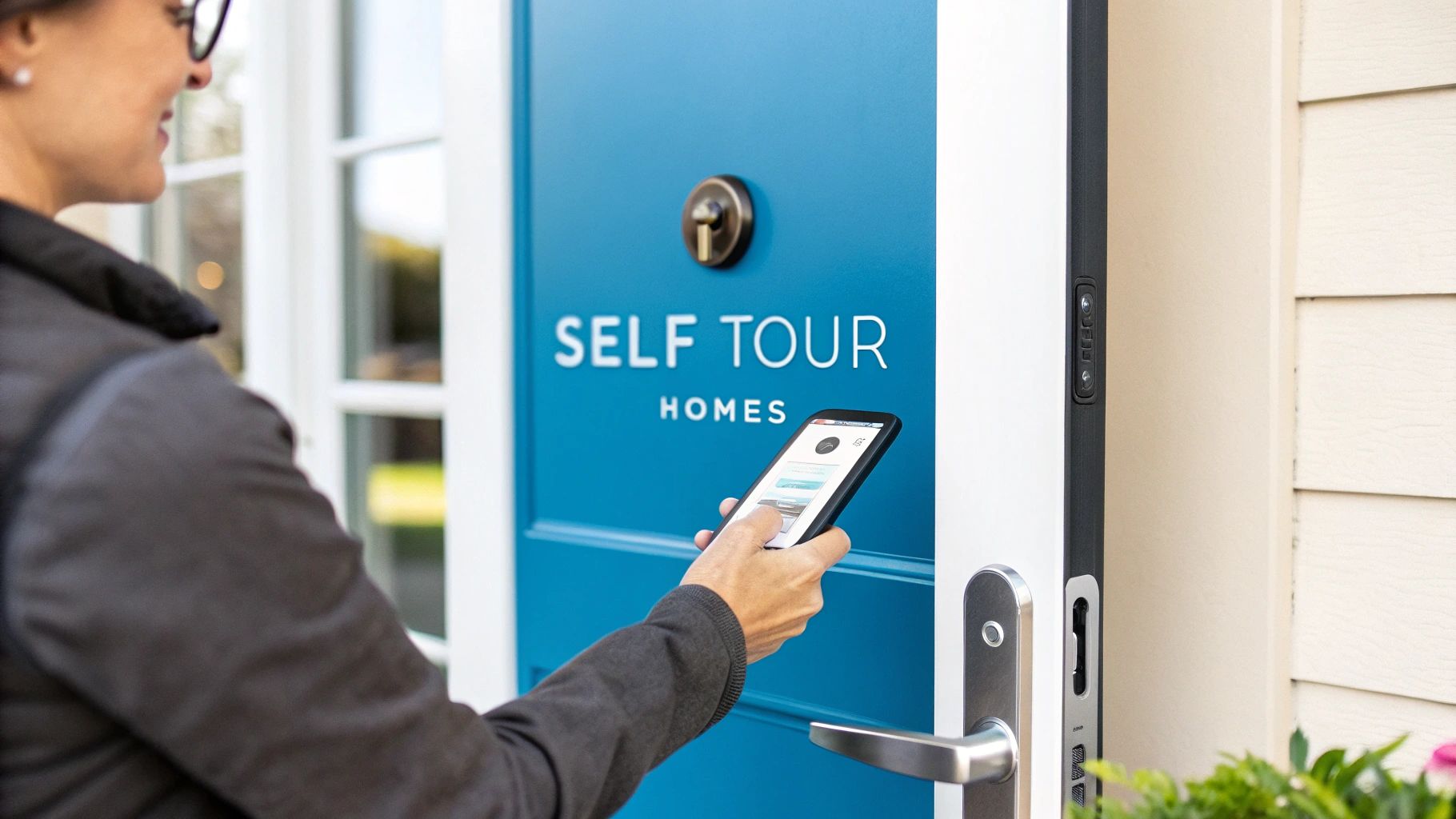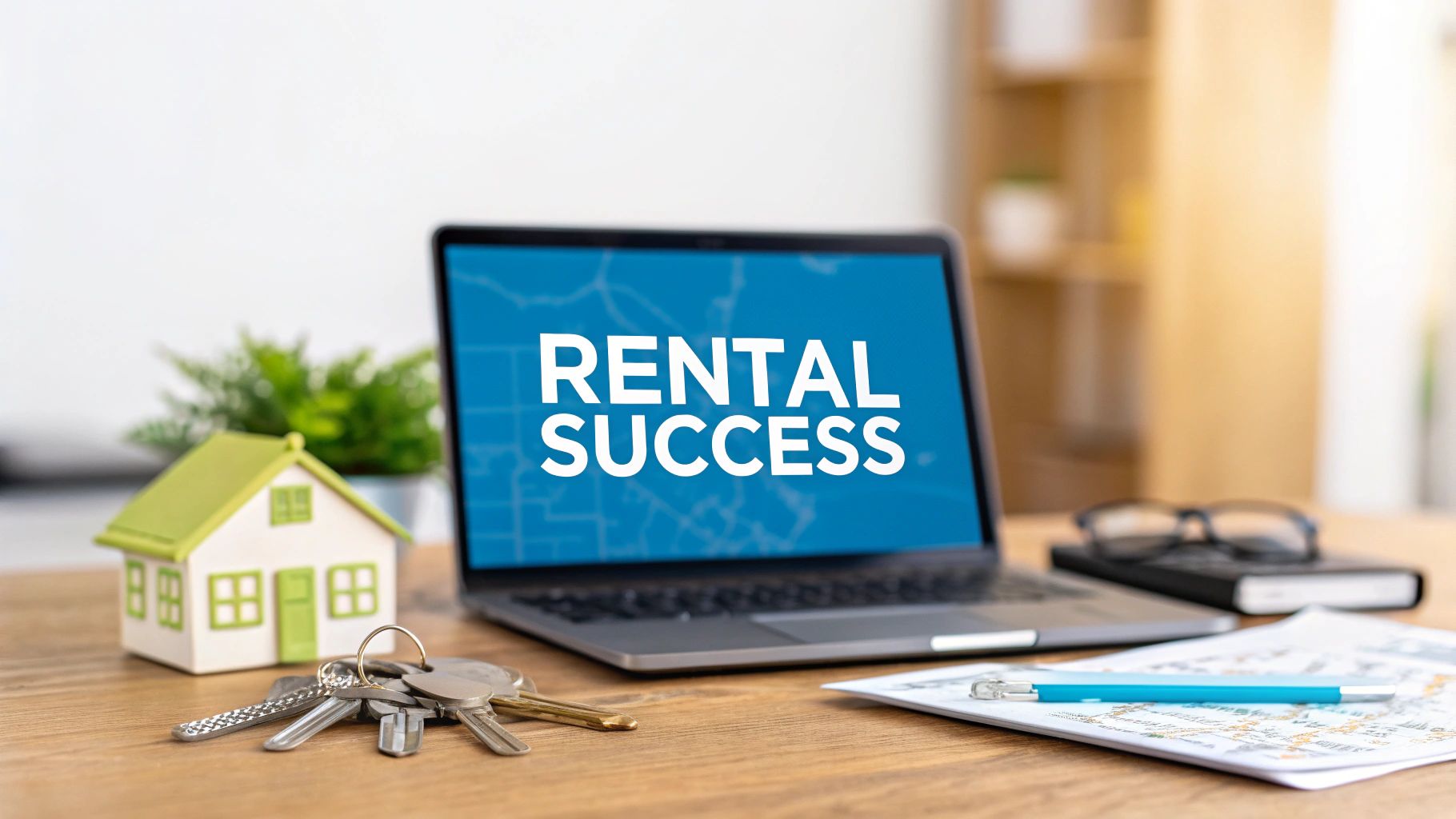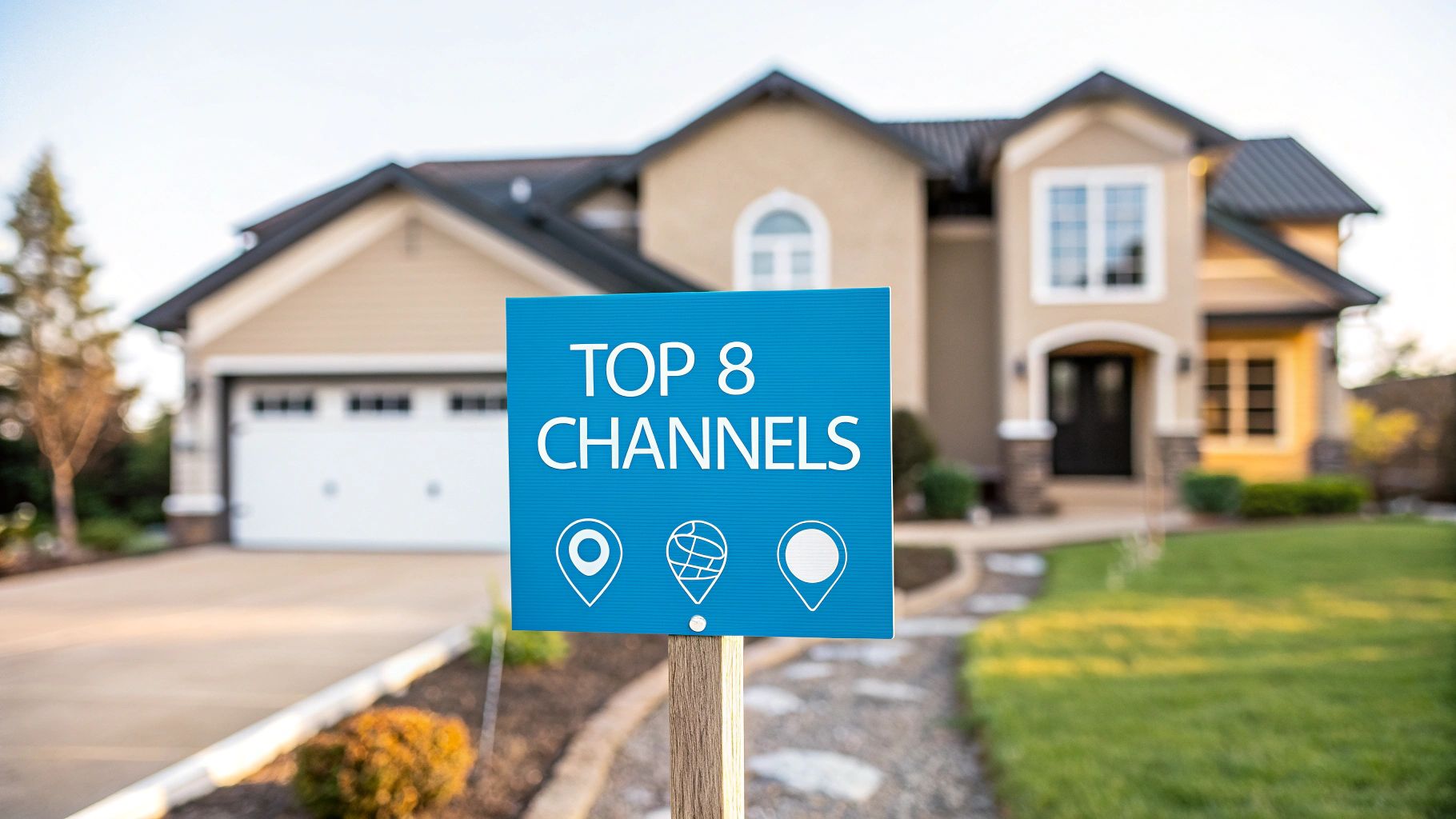Self-touring homes give prospective tenants the power to see a property on their own schedule. By using secure smart lock technology and automated platforms like Showdigs, renters can view a home when it’s most convenient for them, without an agent needing to be there. This on-demand access is a game-changer, meeting the modern renter’s demand for flexibility.
How Self Touring Homes Are Changing Real Estate
Let’s be honest, the old way of showing rental properties is a logistical nightmare. Juggling schedules between your team and a dozen interested renters often leads to missed chances and frustrated prospects. Self-touring homes cut through that friction, creating a much smoother, more efficient process for everyone.
This isn't just about convenience. It’s a bigger shift driven by how people live today. We’re all used to on-demand everything, from ordering dinner to streaming a movie. Renters now bring those same expectations to their housing search. They want to see that perfect property right now, not wait until next Tuesday at 3 PM for an appointment.
The Shift from Agent-Led to On-Demand
The real difference comes down to control and timing. With a traditional showing, the agent runs the show. They set the schedule, lead the tour, and control the conversation. While it's the classic model, it creates bottlenecks that can really slow down your leasing pipeline.
Now, flip that script. The self-tour model puts the renter in charge. They can book a tour online in minutes, get a one-time access code, and walk through the home at their own pace. That feeling of autonomy is huge. It lets them talk openly with their partner or family about the space without feeling pressured or watched.
This operational shift is already making waves in the real estate market. The global residential real estate market is on track to grow from $10.11 trillion in 2024 to an estimated $10.63 trillion in 2025. Much of that growth is fueled by new renter behaviors, especially the strong preference for the kind of flexibility that self-tours offer. You can find more insights on this market shift and its link to real estate technology trends.
Key Takeaway: The move to self-touring isn't about getting rid of agents. It’s about meeting modern renters where they already are: online and on their own time. It's simply adapting to a world that runs on instant access and self-service.
A Clear Comparison
To really see why this is catching on so fast, it helps to put the two methods side-by-side. The differences make it obvious why so many property managers are making the switch.
Self Touring vs Traditional Showings
As you can see, self-guided tours are far more than just a cool gimmick. They deliver real benefits in leasing efficiency, the renter’s experience, and the data you can use to make smarter decisions. By automating the showing process, you can dramatically cut down on vacancy days and free up your team to focus on high-value work instead of just playing schedule tag.
Choosing Your Self-Touring Tech Stack
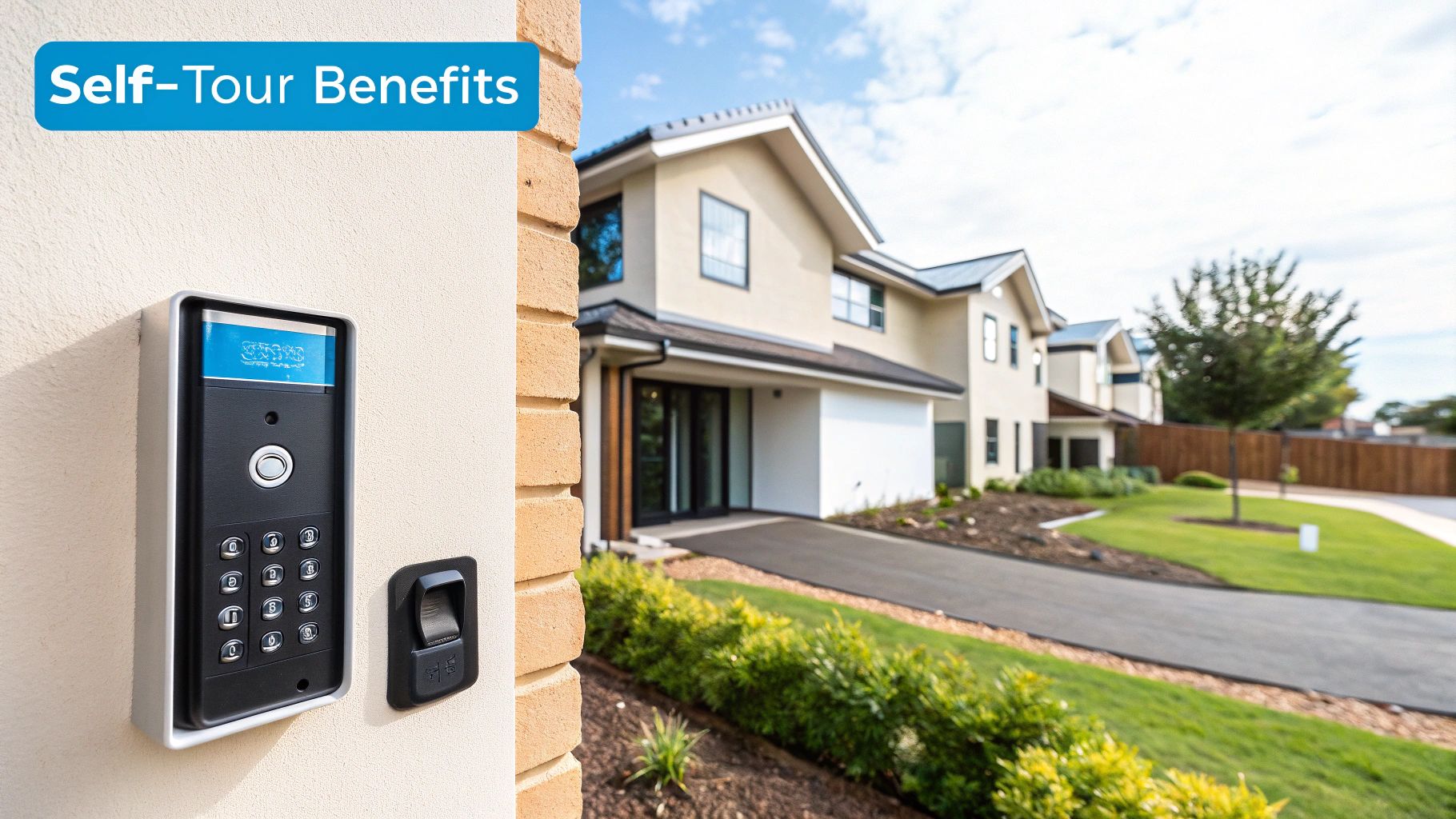
Putting together a solid system for self-touring homes boils down to picking the right technology. This isn't about buying the flashiest new gadget. It’s about building a seamless tech stack where every part works together to give prospects a secure, easy experience while making your job simpler.
Your self-tour setup really has two core components: the physical hardware you install at the property and the software that runs the show behind the scenes. Nail this combo, and you'll have a leasing operation that feels smooth and professional for everyone involved.
Evaluating Smart Lockboxes and Hardware
Think of the smart lockbox as the gatekeeper for your rental. It’s probably the most critical piece of hardware you'll choose, and it has a huge impact on security, reliability, and what a prospect thinks of your property from the get-go. Not all lockboxes are the same, so you need to look past the price tag.
First, consider the environment. A lockbox baking in the Arizona sun has different needs than one getting hammered by rain and snow in the Northeast. Durability is a must. I always look for models with high weather-resistance ratings (IP66 or better) and a build that can clearly take a beating.
Next up are the practicals: power and connectivity.
- Battery Life: How long will it last, and more importantly, how do you know when it’s running low? A dead lockbox means a canceled tour and a very unhappy prospect. You want systems with batteries that last for months, not weeks, and that send you automatic low-battery warnings.
- Connectivity (Bluetooth vs. Wi-Fi): Bluetooth lockboxes are the standard for a reason—they're reliable for close-range access when a prospect is at the door with their phone. But Wi-Fi-connected locks give you the power to grant or revoke access remotely, which is a huge plus. The best systems often use both for total flexibility.
Selecting the Right Scheduling and Management Software
If the lockbox is the gatekeeper, the software is the brain of your entire self-touring operation. This is what connects your listings to the lockboxes and manages a prospect’s journey from their first click to their post-tour feedback. A clunky, unreliable platform will cause more problems than it solves.
Your scheduling software needs to do much more than just book appointments. It has to be your command center for security and communication.
Expert Tip: The best self-touring software doesn't just automate access; it automates trust. Strong identity verification is the most important feature to protect your assets.
When you're vetting platforms, look for a complete suite of features built specifically for the chaos of property management. Here are the non-negotiables:
- Robust ID Verification: This is your first and best line of defense. The software must require prospects to upload a government-issued ID and perform a "liveness check" to prove they're a real person. Some platforms go a step further and require a credit card hold for an added layer of security.
- Automated Communications: Think about all the time you'll save. From tour confirmation texts to follow-up emails asking for feedback, solid automation ensures no lead ever gets forgotten or falls through the cracks.
- Seamless PMS Integration: Your self-touring system can't be on an island. It needs to talk to the tools you already rely on every day. When building your tech stack, see how specialized systems connect with broader property management platforms like Uplisting.
Picking the right software is a big decision that will shape your entire leasing process. It's absolutely worth your time to compare a few options and see what truly fits your portfolio. For a deeper dive, check out our guide on how to choose the right self-showing software.
Ultimately, your goal is to build a tech stack that works so well you barely notice it's there.
Alright, let's get your first self-touring property set up. It’s about more than just slapping a lockbox on the door; it's about creating an experience that's smooth, secure, and genuinely appealing to renters.
The goal is pretty simple: take a vacant property and turn it into a show-ready home that essentially leases itself. I've found this process breaks down into three key areas: getting the physical hardware installed, setting up the software on the backend, and then writing a listing that gets people excited to tour.
Installing and Testing the Hardware
The smart lockbox is the physical key to your property, so getting this part right is non-negotiable. You’ll want to pick a spot for it that's secure, easy to see, and accessible. A front doorknob or a solid railing near the entrance usually works best. Whatever you do, don't hide it in some dark, creepy corner—that’s a quick way to make a prospect feel unsafe and give up.
Once the lockbox is securely attached, you need to do a full dry run yourself. Seriously, don't even think about letting a renter try it until you've walked through the entire process.
- Pair the lockbox: Follow the manufacturer's guide to sync the lockbox with your software, like Showdigs. It’s usually a quick Bluetooth pairing from your phone.
- Generate a test code: Create a temporary access code through your software, just like a prospect would get.
- Walk through the tour: Head to the property and use that code to open the lockbox. Grab the key, open the door, and then put everything back just as you found it.
This little test does two crucial things. First, it confirms all the tech is talking to each other correctly. Second, it gives you a feel for the process from the renter's point of view, so you can spot any awkward steps you might have missed.
Pro Tip: Always keep a spare physical key somewhere safe and off-site. Tech is reliable, but a backup plan for emergencies is just smart property management.
Configuring Your Software and Automation
Hardware is set. Now it's time to jump into your digital command center. This is where you’ll set the rules that automate showings, screen your leads, and keep your property safe. A platform like Showdigs really shines here, pulling all these controls into one clean dashboard.
This is the kind of intuitive interface you'll be working with to manage listings and showings.
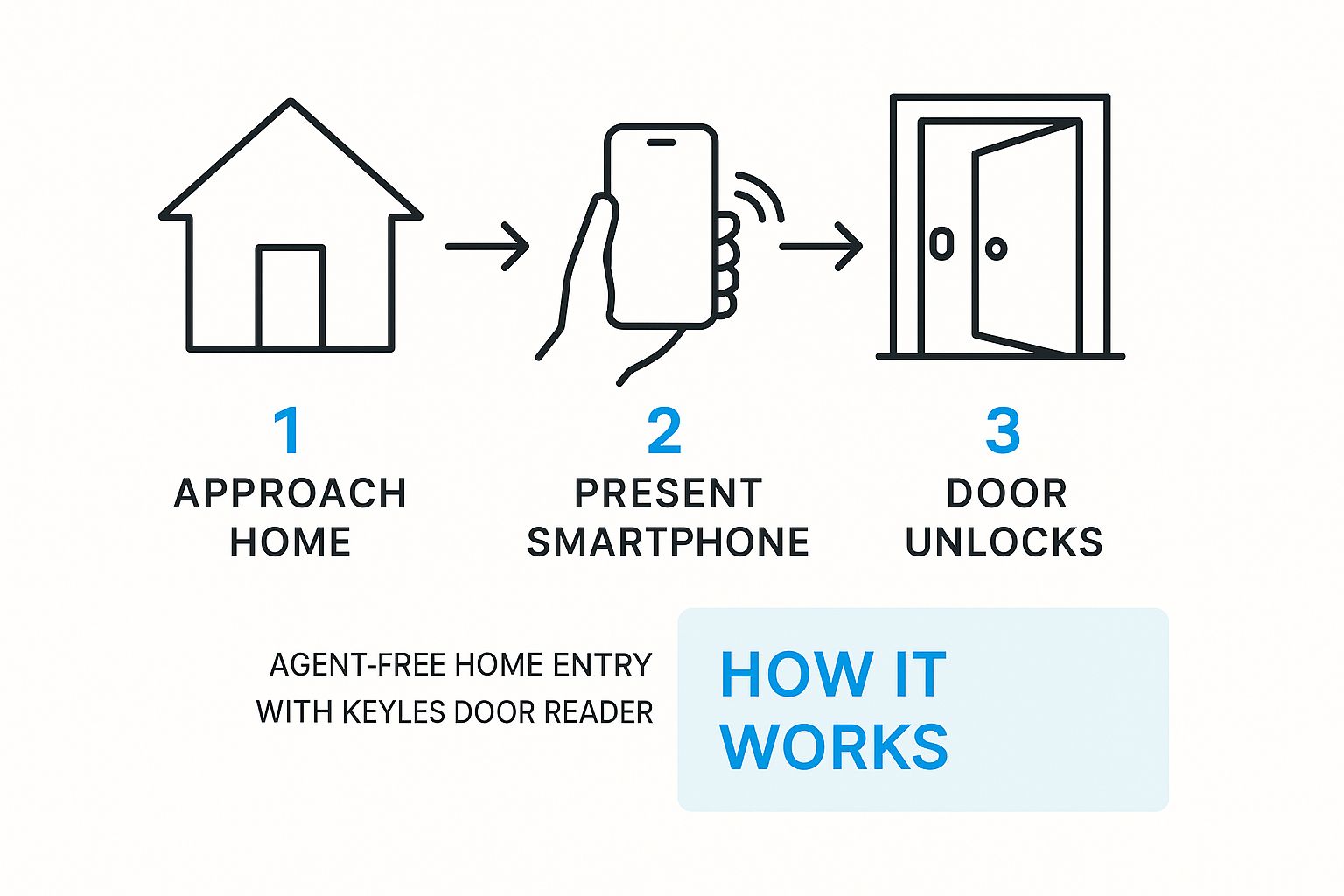
A clear, at-a-glance view like this makes it so much easier to handle a high volume of leads without getting swamped.
Next up is defining the rules for your self touring homes. Here are the key settings to configure:
- Showing Availability: Decide on the hours and days for self-tours. Most of us allow tours from sunrise to sunset, seven days a week, to give prospects maximum flexibility.
- Security Protocols: This is the most important part. Turn on your security features. At a minimum, you absolutely need to require government ID verification and a liveness check. For an extra layer of protection, consider requiring a credit card on file before confirming the tour.
- Automated Messaging: Set up your communication templates. This should include an initial confirmation email, a reminder text with the access details sent just before the tour, and a follow-up message asking for feedback and linking to your application.
Once this is all configured, your system can handle lead qualification and scheduling 24/7 on its own. You can literally be leasing properties while you sleep.
Crafting a Compelling Listing and Clear Instructions
The final piece of the puzzle is making sure your listing actually attracts prospects and highlights this awesome feature. Don't just mention self-tours—sell it as a major benefit.
Use phrases that grab attention, like "Tour Today on Your Schedule!" or "Instant, On-Demand Self-Tours Available." This speaks directly to modern renters who expect convenience and control.
Most importantly, you have to provide dead-simple instructions for the tour. From my experience, confusion at the doorstep is the #1 reason self-tours fail. In your confirmation message, lay it out clearly.
Something like this works perfectly:
"Welcome to your self-tour of 123 Main Street!
- Arrive at your scheduled time.
- Find the smart lockbox on the front door.
- Enter your unique code: [Code].
- Grab the key and enjoy the tour! Please return the key and lock the door when you're finished."
That level of clarity prevents panicked phone calls and ensures renters have a positive, professional experience from the get-go. By being thoughtful about the hardware, software, and marketing, you’ll set yourself up for a successful launch.
Implementing Smart Security and Safety Protocols
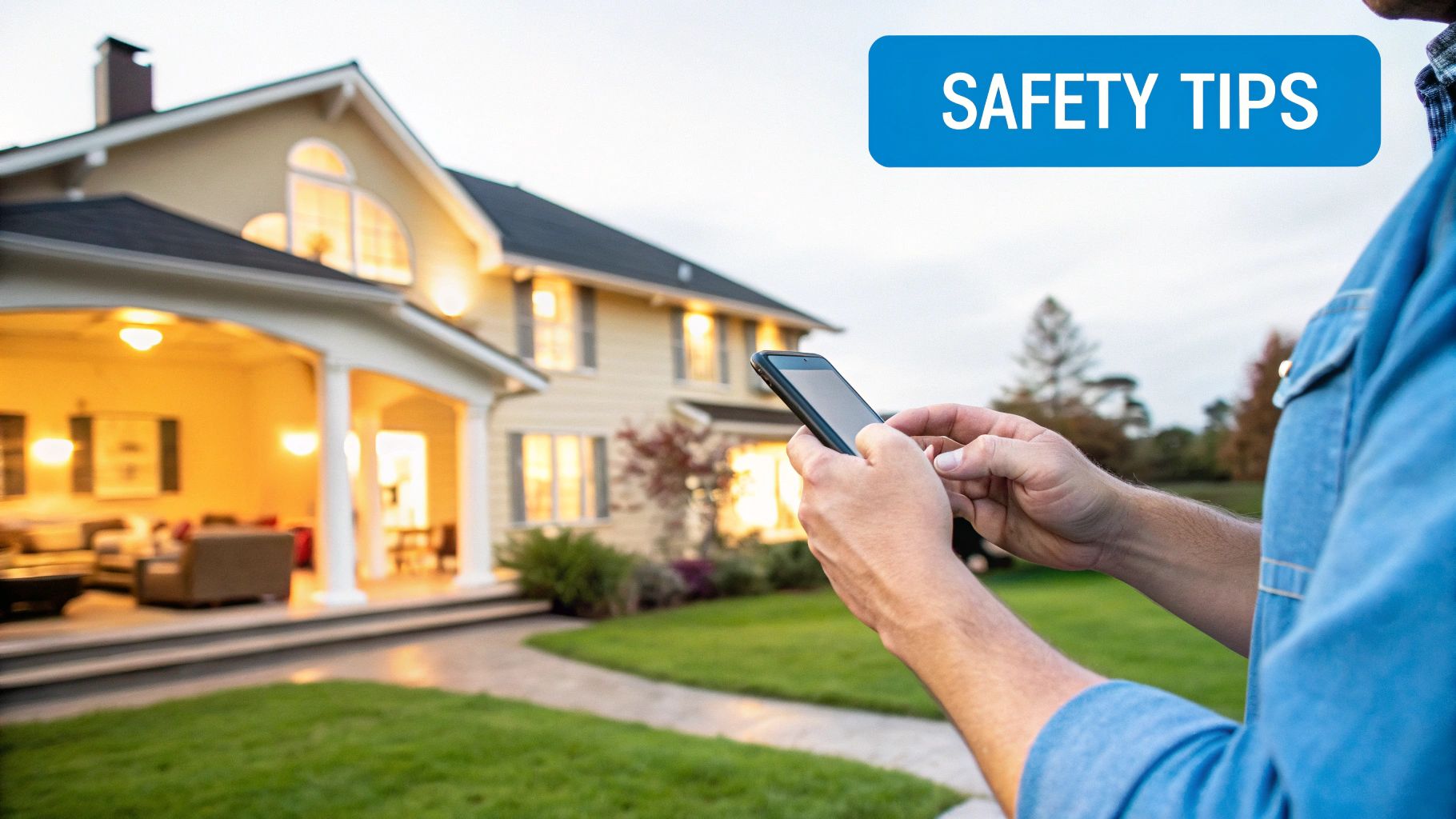
Let's be honest, security is the first thing that comes to mind when you hear about self-touring homes. The idea of handing keys over to a complete stranger can feel like a huge leap of faith. But here’s the thing: modern tech gives you far more control and verification than you’d get from a traditional showing.
The secret isn’t one single gadget; it's a layered strategy that confirms who someone is, tightly controls when they get access, and keeps an eye on the property. You're not just leaving a key under the mat—you're building a digital fortress that only opens for pre-screened individuals during a very specific window of time. Let’s walk through how to build out this framework for total peace of mind.
Verifying Prospects Before They Step Inside
Your first line of defense is knowing exactly who wants to see your property. The old days of just taking a name and number over the phone are long gone. Today's self-touring platforms make robust identity verification a non-negotiable part of the process, stopping bad actors before they even get a code.
This process should be mandatory for every single tour. Leading platforms like Showdigs bake this right into their system, requiring prospects to complete a few quick steps on their smartphone:
- Government-Issued ID Scan: Prospects upload a clear photo of their driver's license or another official ID. The software instantly verifies that it's a legitimate document.
- Liveness Check: This is the critical part. The person has to take a real-time selfie. The system then uses facial recognition to match their live face to the ID photo, proving they are who they say they are.
- Credit Card Hold: As an extra deterrent, many property managers place a small, temporary hold (like $1.00) on a prospect’s credit card. This confirms they have a valid card and adds another layer of financial accountability.
This digital vetting is infinitely more secure than meeting a stranger who only gave you a first name. You have a documented, verified record of everyone who requests access.
By requiring digital ID verification and a credit card hold, you filter out 99% of individuals who might have malicious intent. Serious renters who are genuinely interested in the property will have no problem completing these simple steps for a secure viewing experience.
The Power of Time-Sensitive Access Codes
Once a prospect is verified, the next security layer is controlling their access. This is where smart lockboxes and unique access codes are absolutely essential. Never, ever use a single, repeating code for all your showings. That’s just asking for trouble.
Instead, your self-touring software should generate a unique, one-time-use code for every single tour. This code is tied to a specific person and a specific time.
Here’s how it works in the real world: A prospect, Jane, gets verified and books a tour for Tuesday at 2:00 PM. The system sends her a code that will only work on that specific lockbox between, say, 2:00 PM and 3:00 PM that day. If she tries it at 1:55 PM or 3:05 PM, nothing happens. Once she uses it, the code is dead forever.
This dynamic system means even if a code were somehow shared, it would be useless after the appointment. It’s the digital version of an agent meeting someone, unlocking the door, and locking it securely behind them when they leave.
Smart Monitoring Without Invading Privacy
Your final layer is monitoring the property itself. The key here is to balance security with a prospect's right to privacy. Nobody wants to feel like they’re being watched by hidden cameras while trying to imagine themselves living in a new home.
A smart, ethical approach focuses on the property's exterior and key data points, not the interior.
When you combine these three layers—strict verification, time-locked access, and intelligent monitoring—you create a secure environment for self-touring that crushes risk while opening up your leasing opportunities.
Using Tour Data to Maximize Your Leases
Once you flip the switch on self-touring homes, you’re not just offering convenience—you're opening up a goldmine of information. Every tour booked, every person who steps inside, and every piece of feedback they leave is a breadcrumb leading you toward faster leases. The real power isn't just in the on-demand access; it's in what you do with the analytics afterward.
This goes way beyond just filling a vacancy. When you start analyzing your tour data, you can fine-tune everything from your marketing spend to your rental rates, making sure every decision is driving the best possible return. It's about turning tour activity into tangible leasing performance.
Turning Tour Feedback into Action
The minutes right after a tour are your golden hour. A prospect has just walked through the property, and their first impressions are fresh and unfiltered. This is the perfect moment to capture their thoughts and nudge them toward the next step.
Good self-touring software can handle this for you automatically. You can set up workflows that fire off the second a tour ends:
- Instant Feedback Request: A quick text or email asks for a simple star rating (say, 1-5) and a comment. This gives you an immediate pulse on what prospects are loving—or what’s turning them off.
- Targeted Application Push: If a prospect leaves a great rating (4 or 5 stars), the system can instantly send a follow-up message with a direct link to your online application. It strikes while the iron is hot and removes any friction.
This kind of automated, intelligent communication creates a far better experience for the lead. To see just how seamless this can be, you can get an inside look at the Showdigs self-showing leads experience.
Real-World Example: Imagine you keep getting feedback that renters love a unit's updated kitchen but think the main bathroom feels stuck in the 90s. That’s not just a complaint; it’s a bright, flashing sign telling you exactly where to put your renovation dollars for the biggest impact. Without that direct insight, you might have wasted money on upgrades that didn't really matter to prospects.
Analyzing Data to Optimize Your Strategy
Think of your self-touring platform as more than a scheduler—it's an analytics engine. Digging into the data reveals patterns that are almost impossible to catch with traditional, agent-led showings. You can track key metrics that should directly inform how you market and lease your properties.
The shift to self-touring has exploded, especially as the U.S. housing market has tightened. With new homes for sale expected to hit 481,000 in early 2025—the highest level since 2007—property managers need every edge they can get. Self-touring technology gives you that edge by opening up showing availability well beyond the 9-to-5, which directly accelerates your leasing velocity. To learn more about this trend, see how market conditions influence real estate technology.
Key Metrics to Monitor
Here are a few of the most valuable data points you should be keeping an eye on:
By regularly reviewing these numbers, you stop guessing and start knowing. You can adjust your pricing with confidence, put your marketing dollars where they’ll actually work, and shrink your vacancy periods. This data-driven approach is what elevates self-touring from a simple convenience into a core part of a high-performance leasing strategy.
Common Questions About Self-Touring Homes
Even with the obvious upsides, most property managers I talk to have some very practical questions about how self-touring homes actually work in the real world. Let's get into the most common concerns and give you some direct, straightforward answers to help you feel confident about this approach.
How Do You Prevent Property Damage or Theft?
This is always the first question, and for good reason. The truth is, a good self-touring system isn't just about a fancy lockbox; it’s about a layered security strategy.
It all starts with serious digital ID verification before a prospect even gets approved for a tour. This isn't just a name and email. We're talking about scanning a government-issued ID and often doing a "liveness check" to make sure the person on the ID is the one standing there.
Then, the system generates unique, single-use access codes that only work during the scheduled tour window. Once that time is up, the code is useless. No unauthorized re-entry. Some platforms, like Showdigs, go a step further by putting a temporary hold on a credit card. This simple step adds a layer of financial accountability that weeds out most people with bad intentions. While you can't put cameras inside (that's a huge privacy violation), a well-placed camera at the entryway is a smart move to record who comes and goes.
Key Insight: A multi-layered security approach—combining strict ID verification, time-sensitive access codes, and credit card holds—creates a system that is often more secure than traditional showings where vetting can be inconsistent.
What Happens If a Prospect Has Trouble with the Lock?
Tech glitches are a reality. That's precisely why choosing a provider with top-notch support is non-negotiable. The best self-touring platforms have real-time support for prospects, usually through a quick phone call or live chat, so they can troubleshoot access issues on the spot. You can't risk a frustrating experience that costs you a great tenant.
To get ahead of this, make sure your instructions are crystal-clear. The automated confirmation and reminder messages should include a simple, step-by-step guide on using the lockbox and a direct number for that support line. A little preparation goes a long way in making sure the prospect feels taken care of.
Are Self-Touring Homes Worth It for Smaller Landlords?
Absolutely. It might seem like a tool for big companies, but self-touring tech can be a game-changer for smaller landlords looking for a competitive edge. It lets you offer the same 24/7 showing availability as the big players, all without you having to be physically present for every single tour.
Think of all the time and gas money you'll save. More importantly, it opens up your pool of potential renters to people with non-traditional schedules, like nurses or shift workers who can't just drop everything for a 2 PM Tuesday showing. By automating the process, you get your property in front of more qualified leads, which almost always means shorter vacancy periods.
To dig deeper into whether it's the right fit for your portfolio, you can explore the various pros and cons of self-showings. Ultimately, leasing your property faster directly boosts your bottom line, making this a powerful tool for a landlord of any size.
Ready to cut your vacancy time and streamline your leasing operations with self-touring technology? See how Showdigs combines smart automation with an on-demand agent network to fill your rentals faster. Learn more and schedule your demo today!




